#pathtozerocarbon, #sustainability
01 – An Honest Conversation About Zero Carbon
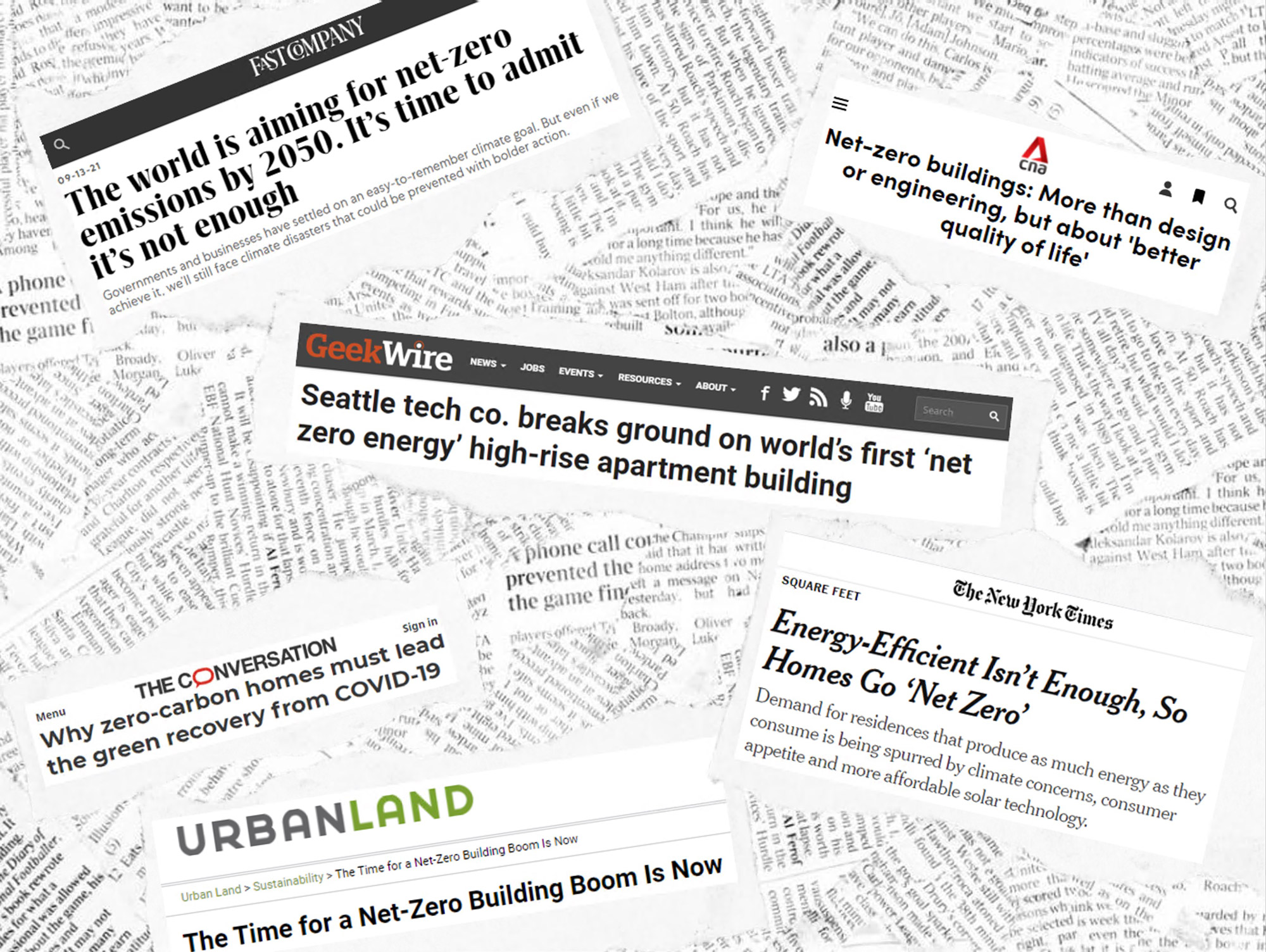
Claims of Net Zero Carbon are frequently in headlines. This claim is challenging because a majority of greenhouse gas emissions associated with a project are excluded from most of the calculations. This series explores what a carbon neutral built environment needs to include to make this claim.
“The youth of today and future generations will look back in horror that our generation gambled with catastrophic changes climate and biodiversity loss for the sake of cheap fossil fuel energy when cost effective and socially acceptable alternatives were available.”
Robert Watson, PHD Chemist from University of London, Atmospheric Chemistry
The Path to Carbon Neutrality
The building sector is rapidly evolving to eliminate our carbon footprint and numerous buildings have been designed toward a vision of a carbon neutral built environment, with the media latching on to zero Very few buildings are truly carbon neutral, however, since most net-zero claims ignore significant emissions sources.
To move forward honestly, we need to use a common terminology and scope definition for net zero carbon and carbon neutrality. Meaningful climate action is too critical to avoid confusing statements that imply carbon neutrality but ignore large emissions sources. While design teams only have control over some of the project emissions, we should honestly and transparently chart and celebrate our progress instead of claiming victory at halftime.
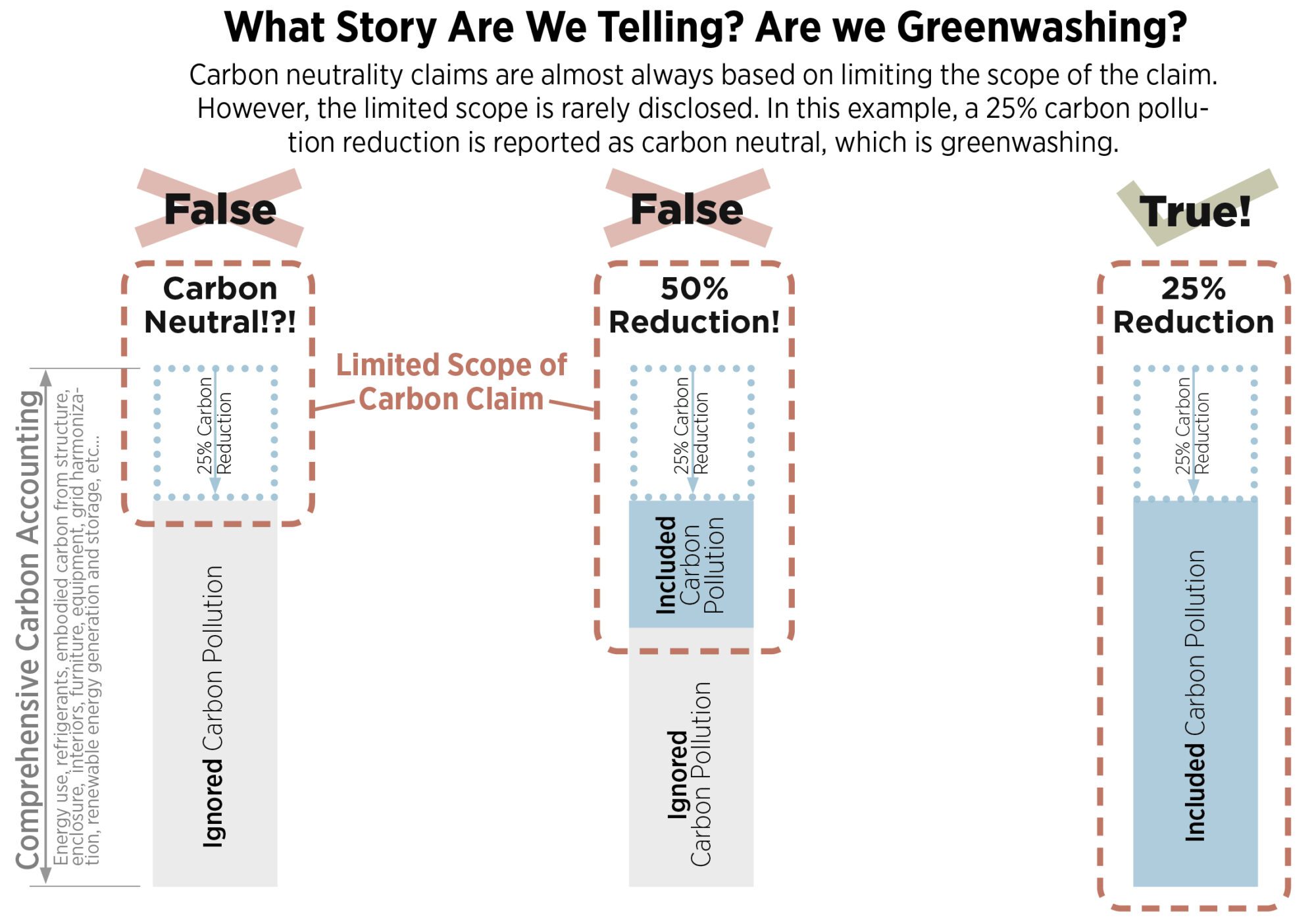
The stories we tell are important. Net Zero Carbon claims are often made without including a full accounting of emissions and may include only a 25 or 50% reduction toward carbon neutrality when a full scope is included. Even advanced rating systems exclude important emissions sources, and some emissions are only marginally within the design team’s control.
This series will critically consider Zero Carbon goals, what they often exclude, and attempt to help LMN Architects and others understand and compare the major sources of emissions from our built environment. We will also identify the challenges and unresolved questions, summarizing tools, methods, and resources to complete the picture of carbon emissions.
Why Design Matters in Climate Change
Architects + Designers are stewards of the built environment. Along with our many industry collaborators, we design and construct millions of individual projects each year that form our homes, schools, sidewalks, towns, and cities, the physical roof over our heads and the stage for our lives. The built environment that we care for emits roughly 50% of climate change causing emissions worldwide.
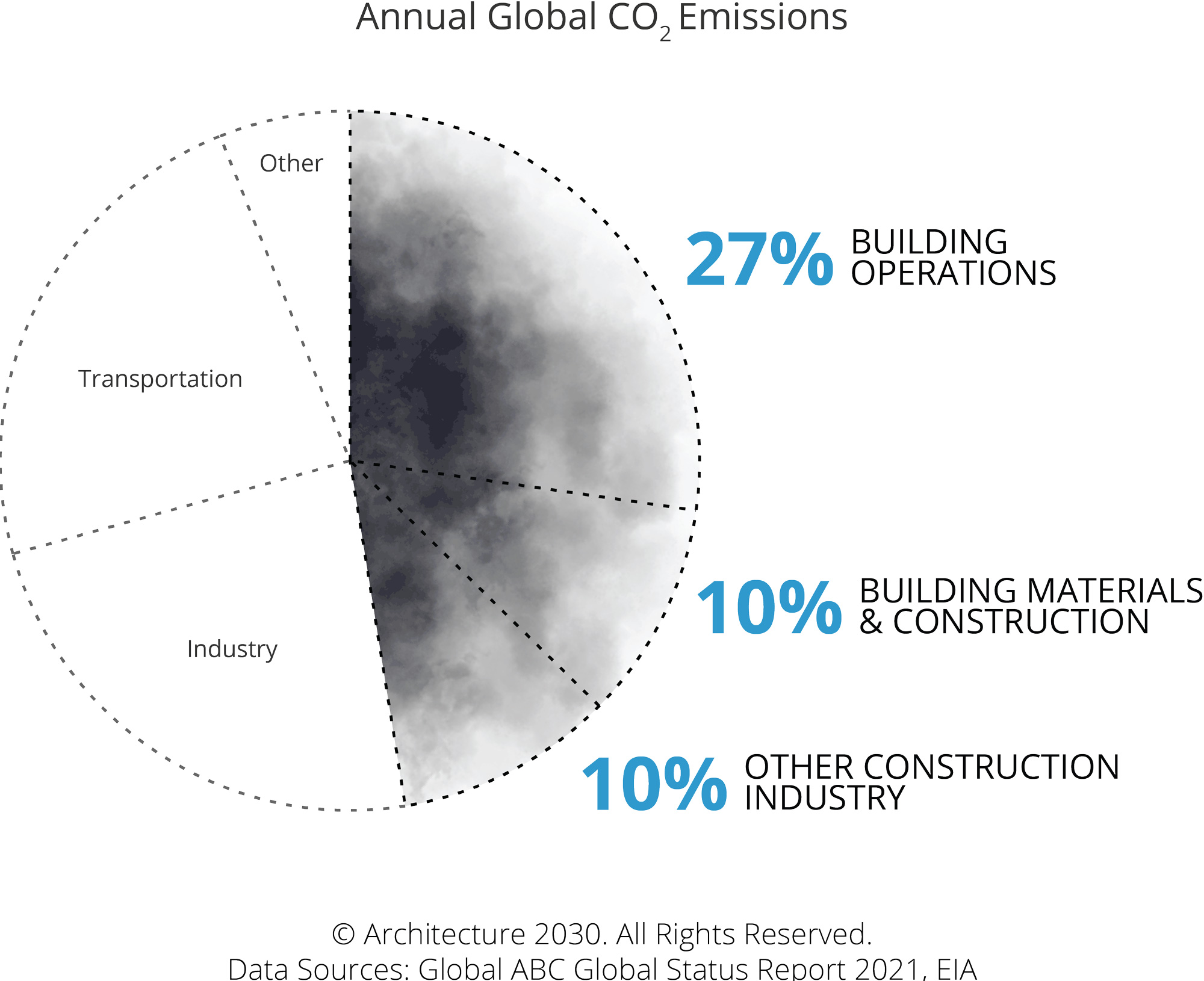
Nearly 50% of global carbon emissions are from built environment: 27% from the energy use, another 10% from building materials and the construction of buildings, and another 10% from other construction of the built environment. All sources need to be addressed urgently.
These emissions have consequences: the list of catastrophes that are made worse by human-caused climate change is well documented, although controversy exists around exactly how much climate change factors into each individual disaster: species loss, wildfires, ocean acidification, heat waves and droughts that impact agriculture and human health, droughts and water shortages, flooding, loss of coastline, hurricanes, forced human migration, and war.
The built environment is not just a primary cause of climate change, it is also where much of the climate disruption impacts humanity directly: increasing floods, hurricanes, and wildfires destroy buildings; heat waves lead to premature deaths and droughts affect livability and damage public infrastructure.
Consciousness and culpability for carbon emissions have grown rapidly over the last few decades and we now have a moral obligation to act decisively to remain within a carbon budget. This is reflected in many organizations’ urgent focus on reducing emissions, including American Institute of Architects (AIA) and the updated Code of Ethics, the UN Conference of Parties on Climate Change, ASHRAE, ArchitectsCAN, and a long list of others. Each of these organizations believes that emissions can be substantially reduced on all projects, today, by properly equipped design teams.
The Invisible Cost of Carbon Emissions
Buildings are designed with cost pressures, including the cost of materials, labor, and operating costs such as energy and water bills. However, no entity receives a carbon bill, despite the widespread damage that climate change causes each year. This a classic “tragedy of the commons” problem, compounded because emissions are largely invisible and rely on complex measurements and accounting.
Climate-change causing emissions are financial ‘externalities,’ since carbon emissions are not assigned a financial value within our economic system. This means when materials and systems are selected for a building, the impacts on climate change are not considered as financial pressures are applied. It also means that emitters do not pay to compensate those who suffer damage as a result of climate change or to prepare for and repair that damage.
Some countries, states, and ambitious companies (including California, the UK, Colorado, New York, Microsoft(1, 2), Washington State, and the US) have put a voluntary price on carbon (often called a ‘Social Cost of Carbon’) to bring these externalities into their financial picture, to incentivize carbon reductions, and sometimes to compensate others for damage suffered. Emissions have been attributed a social cost because they damage our environment’s ability to provide ‘ecosystem services’ that are worth trillions of dollars annually to humanity and support all life on earth: temperature regulation, clean air, clean water, fisheries and agricultural productivity, and much more.
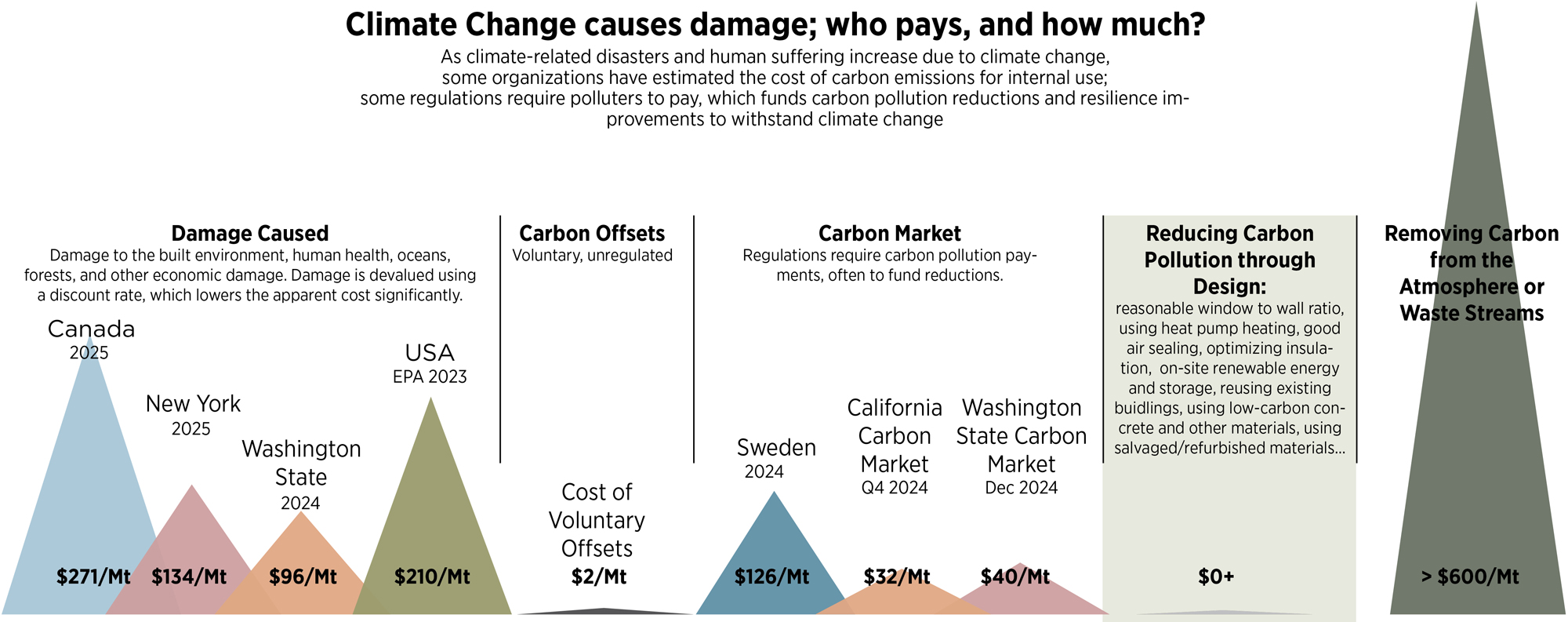
Estimating the cost burden from emitting carbon varies widely: California, United Kingdom, Colorado, New York, Microsoft, Washington State, and the United States have all adopted policies suggesting it is significantly higher than the market price of carbon offsets. These estimates also include a discount rate to account for prioritizing near-term actions, generally around 3%. Washington State, for example, uses a Social Cost of Carbon within the Life Cycle Cost Assessment Tool Excel File for use within the buildings industry.
To mitigate carbon emissions, carbon offsets provide a market-based opportunity to reduce or sequester carbon based on price. There is a massive gap, however, between what a carbon offset costs ($2/ tCO2e toward the low end) and estimates of the social cost of carbon (often above $50/tCO2e), showing the vast economic disconnect as entities try to bring this externality into economic calculations.
While low-cost carbon offset projects can decrease carbon emissions, higher cost options provide more confidence, transparency, and additionality of carbon claims based on offsets. Based on research for writing an upcoming post on carbon offsets, LMN Architects believes that nearly all options are too slow, vaguely defined, or too full of caveats to make carbon neutrality claims for buildings. Because of this we need to focus almost exclusively on reductions in carbon emissions.
Architects are used to working with externalities since we often advocate for the public interest on our projects, even when the public does not pay for our services. Until carbon pollution ceases to be an externality, advocating for carbon reductions as a public good is the path forward.
Climate Resilience + Equity
The increasing adoption of Social Cost of Carbon metrics results from the reality that while solutions to combat climate change have a financial cost, not addressing it also has a very large cost and is considered more costly than reaching net zero. The United States, for example, emitted approximately 5.2 Gigatons of CO2e in 2020. At a social cost of carbon of $50/tCO2e, this suggests the monetized impact is hundreds of billions of dollars annually.
Rather than waiting for a crisis, many cities and residents are investing in climate resilience strategies, attempting to preempt climate threats in numerous ways: constructing seawalls and barriers to protect building stock, increasing mechanical cooling capacity to deal with heat waves, building stormwater management systems, hardening structures to withstand stronger winds and tides, and in many other ways. These responses are expensive and not available to everyone. They can also be incredibly carbon intensive without a guarantee of protection if done without an eye towards long-scale larger-system resilience. In the face of the significant cost of response and recovery, some communities are being forced into displacement or, in a few rare and ongoing cases, a careful managed retreat.
The distribution of climate risks and costs worldwide are uneven and cause further inequity. The world’s largest economies are responsible for the majority of the carbon pollution, while the harmful effects fall disproportionately on less wealthy, more vulnerable places and people. Areas with lower GDP are much more likely to not be able to afford climate mitigation strategies to find new water sources, protect citizens from extreme heat, and relocate or build sea walls to avoid sea level rise-related flooding.
Climate pollution also pollutes local air and water, negatively affecting communities disproportionally based on race and economic class and includes fenceline communities that have statistically worse health than other areas. As a remedy, the Climate Justice movement focuses on aligning the continuing wealth creation from unrestricted carbon pollution with its burden, as well as ensuring an equitable transition to the new, green economy.
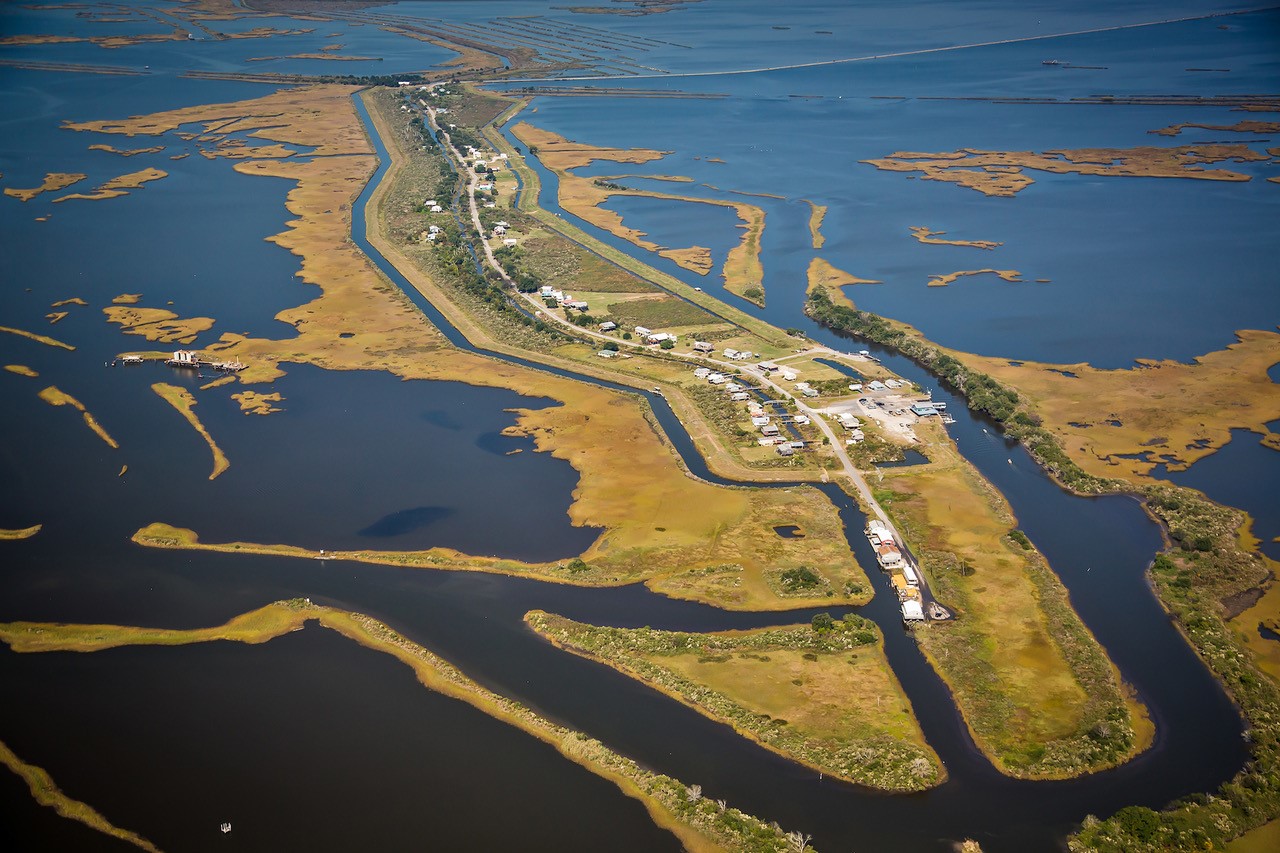
Isle de Jean Charles is the historical homeland and burial ground of the state-recognized Isle de Jean Charles Band of the Biloxi-Chitimacha-Choctaw Tribe in Louisiana. The island is a narrow strip of land in the Louisiana delta that lies outside of the levee system that protects New Orleans and its surrounding suburbs from floods and storm surge. Since 1955, the island has lost 98% of its land through saltwater intrusion and subsidence exacerbated by the channels carved through the wetlands for offshore drilling projects and oil pipelines. Today, the Isle de Jean Charles community is a part of one of the first managed retreat projects in the United States. Photo credit: Julie Dermansky

Series Outline
First, a note: for this series and linked resources, the terms “carbon,” “carbon neutral,” “carbon emissions” and “carbon pollution” will be used to refer to all greenhouse gas emissions, not just carbon dioxide, though carbon dioxide (CO2) is responsible for the lion’s share of greenhouse gas impacts and therefore gets the most attention. Unless specifically noted otherwise, Global Warming Potential will refer to the 100-year time horizon, known as GWP100; the carbon dioxide equivalent (CO2e) will likewise be based on a 100-year timescale. Some measurements will be in kg of CO2e and others in tonnes (Metric Tons) of CO2e, abbreviated tCO2e. More discussion on this will be in Post 04 – The Science of Global Warming.
Sustainable design leaders in the buildings industry are drowning in sustainable design resources. Even dedicated sustainability experts cannot keep up with the research. In response, we have chosen to summarize very complex fields with many moving parts using our experience and reaching out to a wide range of collaborators. This is an honest exploration of a very near-term and critical problem, in the spirit of failing forward, and is not expected to be definitive to include all possible information, or to imply that LMN’s projects are carbon neutral despite many striving for a zero carbon certifications. We hope that this work is carried forward by a larger group after this initial series.
The goals include identifying resources and robust tools to calculate and reduce carbon emissions where they exist; to provide methods where tools do not exist; and to provide questions and links to studies where no tools or methods exist.
Internally, we will use these findings to revise our 2018 Sustainable Action Plan toward more comprehensive climate action within our projects and advocacy. Our goals for the critical next years until 2030 need to be much more audacious and comprehensive.
This research couldn’t be done without an amazing culture of sharing that already exists in the sustainability world. We are beneficiaries of others’ sharing their research and have attempted to provide credits and links as we can.
Over the course of this series, we’ll broaden the scope of the Net Zero Carbon discussion to attempt comprehensive study of the current state of carbon emissions and reductions. The series will begin with a primer on the science behind global warming and the importance of upfront carbon reductions. We’ll discuss carbon offsets, which provide projects with the negative numbers they need to claim zero impact and include controversy around these numbers, and then we’ll dive into the built environment impacts. We’ll address the importance of building and material reuse, the need to evolve our structural systems, and the tradeoffs between embodied and operational carbon. We’ll bring in emissions typically excluded, such as embodied carbon from mechanical systems and equipment. We’ll study the impacts of interior materials and renovation, which are often excluded from LCA frameworks. And finally, we’ll look at the impacts we have outside the boundaries of the site – of new transportation and infrastructure services that are required by each new project.
With this series, we intend to move beyond the concept of net zero and to create a framework for what it would mean to create a carbon neutral-built environment. We hope that you join us as we explore this important, evolving topic.
Please email any questions or comments to Kjell Anderson, kanderson@lmnarchitects.com
Thanks to our external collaborators and peer reviewers
Vincent Martinez, Arch 2030; Jason McLennan, McLennan Design; Chris Hellstern, Miller Hull; Michelle Amt, VMDO
LMN Architects Team
Huma Timurbanga, Justin Schwartzhoff, Jenn Chen, Chris Savage, Andrew Gustin, Kjell Anderson, Xio Alvarez, Hasti Afkham
Posted: 05/17/2022
Edited: 12/05/2023
Edited: 03/25/2025
The text, images and graphics published here should be credited to LMN Architects unless stated otherwise. Permission to distribute, remix, adapt, and build upon the material in any medium or format for noncommercial purposes is granted as long as attribution is given to LMN Architects.